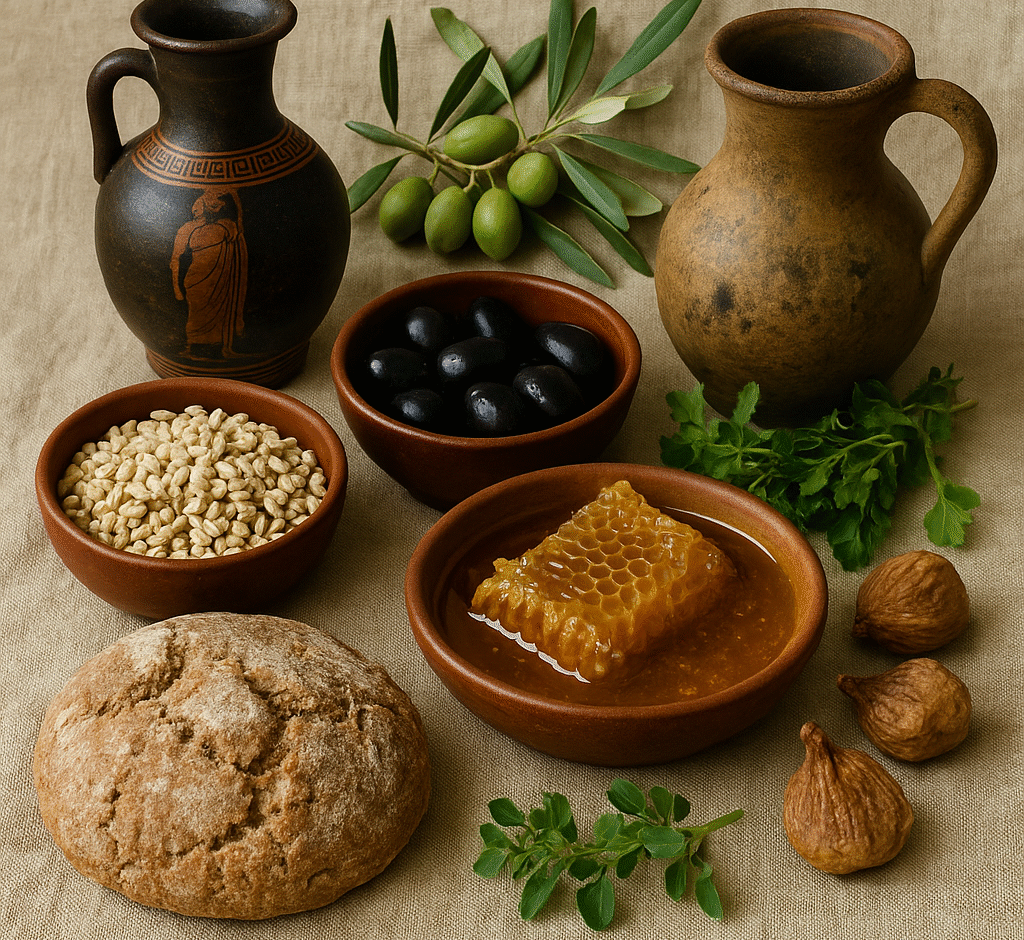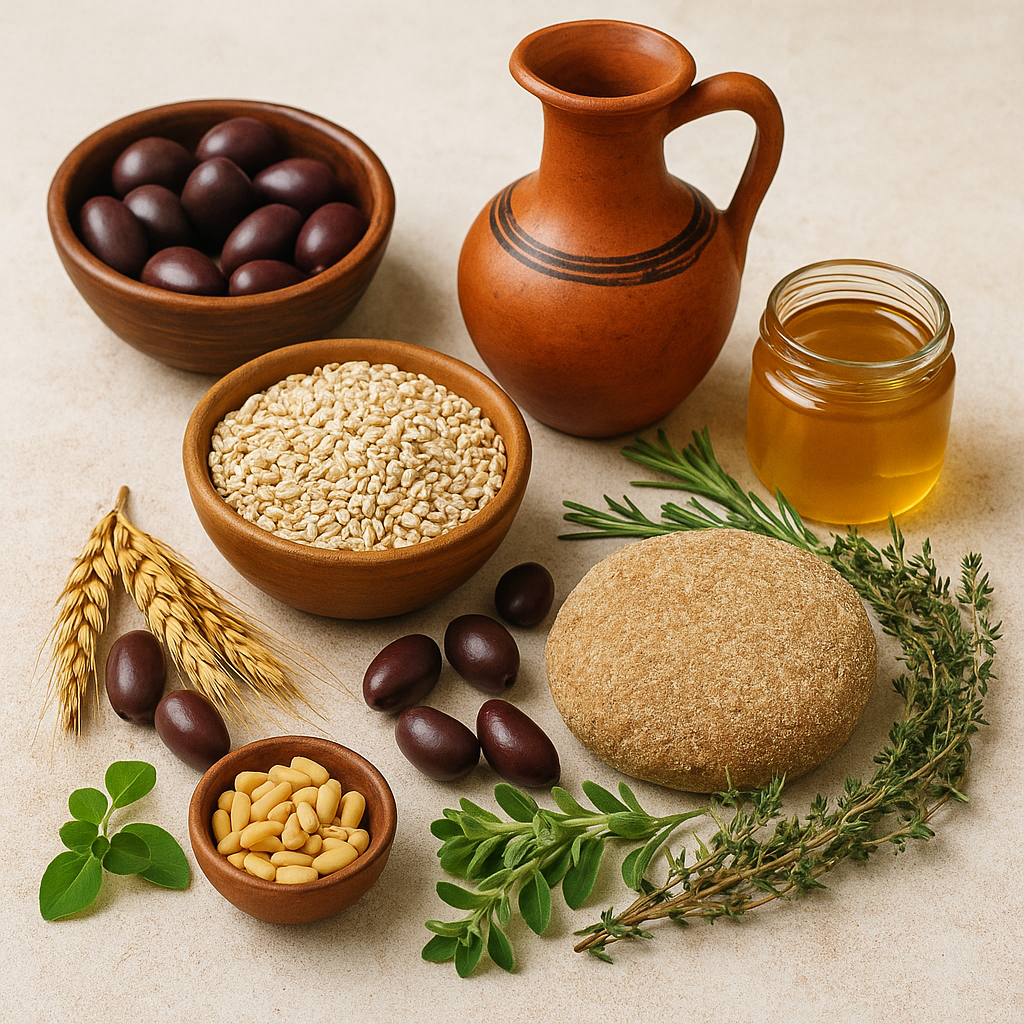🇬🇷 The Rich History of Greek Food: From Ancient Simplicity to Modern Tables
- May 12, 2025
- 0
- 4 Min Read

When most people think of Greek food, they picture grilled souvlaki, warm pita, or creamy tzatziki. But the roots of Greek cuisine go far deeper — back over 4,000 years. Greek food is more than just olive oil and feta. It’s a story of trade, war, religion, family, and love for the land.
This blog isn’t just a timeline — it’s a flavorful trip through history, from the communal feasts of Athens to the village kitchens of today. Grab a cup of Greek mountain tea, and let’s travel.
🏺 Ancient Greece: Simplicity and the Birth of Balance
In ancient times, Greek meals were humble but thoughtful. The core of the Mediterranean triad — bread, wine, and olive oil — was already present by 800 BCE. Wheat and barley were made into flatbreads and porridge. Grapes were pressed into wine. Olives were cured or pressed for oil.
Key staples:
- Lentils and chickpeas
- Honey (used instead of sugar)
- Goat cheese
- Figs and dates
- Wild herbs like oregano and thyme
Meat? Rare. Ancient Greeks valued moderation. Fish and shellfish were common along the coast, but red meat was usually reserved for sacrifices and festivals.
“Let food be thy medicine,” said Hippocrates — and Greek cuisine has followed that wisdom ever since.
🛳️ Roman and Byzantine Influence: Layering the Flavors
When the Romans arrived, they brought luxury — spices, sauces, even garum (a fermented fish sauce). The Greeks embraced some of it, but kept their own culinary backbone.
Later, during the Byzantine era, Eastern influences flowed in from Persia and the Arab world. Spices like cinnamon, nutmeg, and cloves made their way into Greek kitchens — especially for sweets and festive dishes.
This period shaped dishes like:
- Avgolemono soup (egg-lemon broth)
- Baklava (yes, its roots stretch this far)
- Stuffed grape leaves (dolmades)
Religion also played a major role — especially Orthodox fasting seasons, which led to hundreds of vegan-friendly meals like lentil stew, fava mash, and herb-stuffed vegetables.
🌍 Ottoman Period: A Cultural Culinary Exchange
From the 15th century onward, Greek food absorbed many elements from Ottoman cuisine, just as Turkish dishes were influenced by Greek cooks. Many of the most iconic modern Greek dishes — moussaka, pastitsio, koulouri, and loukoumades — have shared roots across the region.
Greek grandmothers (“yiayiás”) preserved family recipes orally during this period, using whatever ingredients were local, seasonal, and affordable. This is when the concept of “kitchen wisdom” — improvising with what’s at hand — became central to Greek home cooking.
🧀 Modern Era: Greek Food Today
Today, Greek cuisine strikes a beautiful balance between old-world simplicity and new-world innovation. Chefs honor traditional ingredients like:

- Feta and kasseri cheese
- Kalamata olives
- Lamb and seafood
- Fresh herbs, lemon, and garlic
…while adding new touches and techniques for today’s tables. Greek food has also become a symbol of hospitality, health, and culture worldwide — a trend driven by its fresh, honest ingredients and balanced approach to eating.
📌 Why Greek Food Still Matters
Greek cuisine is not a trend. It’s a heritage. From ancient symposiums to modern street food stands in Athens, food has always been how Greeks connect with each other — and with their past.
It’s:
- Seasonal
- Locally sourced
- Unpretentious
- Delicious
- Deeply cultural
❓ FAQ: History of Greek Cuisine
Q: Is moussaka originally Greek?
A: Moussaka has Ottoman roots but was popularized in Greece in the early 20th century by chef Nikolaos Tselementes, who added the béchamel topping.
Q: What’s the oldest Greek food still eaten today?
A: Lentil soup (φακές), barley bread, and fig-based sweets date back to ancient Greece and are still staples today.
Q: Is Greek food healthy?
A: Yes! The traditional diet is high in fiber, good fats (olive oil), legumes, fish, and greens — with limited red meat and sugar.














